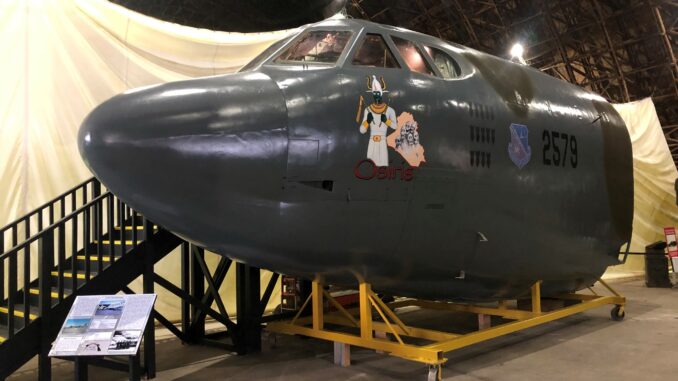
The forward fuselage of Boeing B-52G Stratofortress 59-2579 is approaching the end of a roughly 18 month restoration effort at the Tillamook Air Museum in Tillamook, Oregon. The museum plans to formally unveil their prize on April 1st, 2023, although visitors can already gain a view inside the cockpit via a set of external stairs on the starboard side. Furthermore, the museum will soon allow visitors access inside the ‘offensive’ (below deck) stations, also in the nose.
The B-52, developed as a Cold War strategic bomber, has served the United States in the nuclear deterrent role and as a conventional, heavy bomber since the type entered operational service with the 330th Bombardment Squadron at Castle Air Force Base (AFB) in June, 1955. The B-52 became a veritable poster child for the US Air Force’s Strategic Air Command, which the bomber outlasted and, almost inconceivably, the Stratofortress remains a primary weapon in the present day U.S. Air Force. And with the ongoing re-engining process, that role is likely to continue into the 2040s!
Boeing constructed the museum’s B-52G at their factory in Wichita, Kansas and delivered it to the United States Air Force on September 23rd, 1960. In February 1963, the airplane joined the Air Force’s 397th Bombardment Wing at Dow AFB in Bangor, Maine. On May 16th, 1964, the city of Bangor, Maine received honorary ‘ownership’ of the airplane, with 59-2579 christened as City of Bangor by Sheryllee Kay Jones, ‘Miss Bangor’ at the time, who broke a bottle of champagne on the bomber’s nose.
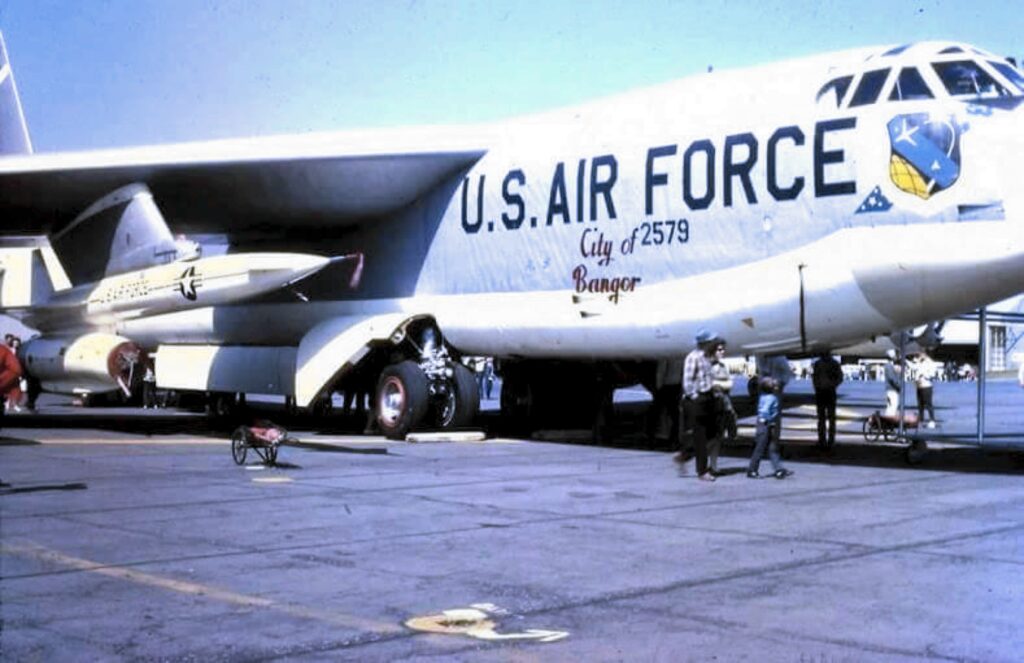
On April 5th, 1968, the B-52 (and a KC-135) became the final two USAF aircraft to depart Dow AFB, which soon closed its military function to reopen as Bangor International Airport, which still serves the public in the present day. The B-52 transferred next to the 2nd Bombardment Wing at Barksdale AFB in Louisiana, before moving back to Maine in April 1972, this time for a brief stint at Loring AFB near Limestone.
On May 31st, 1972, the airplane flew to Andersen Air Force Base in Guam, as part of Operation Bullet Shot, a build-up of B-52 bombers to combat the perceived threat from North Vietnam. Although the museum’s records at the moment are scarce, ‘579 seems also to have participated in Linebacker ll, the intense bombing campaign over North Vietnam from December 18-29, 1972, while at Andersen AFB. Following its 16 month deployment to Andersen AFB, the airplane passed through a number of stations across the continental United States, which featured bases in Texas, California, North Dakota, and Washington. Along the way, the bomber acquired several more nicknames, including ‘Soiee’, ‘Armed & Ready/Make My Day’, ‘Heavy Metal’, ‘Boodrow’, and last of all, ‘Osiris’ the name for the ancient Egyptian god of the dead.
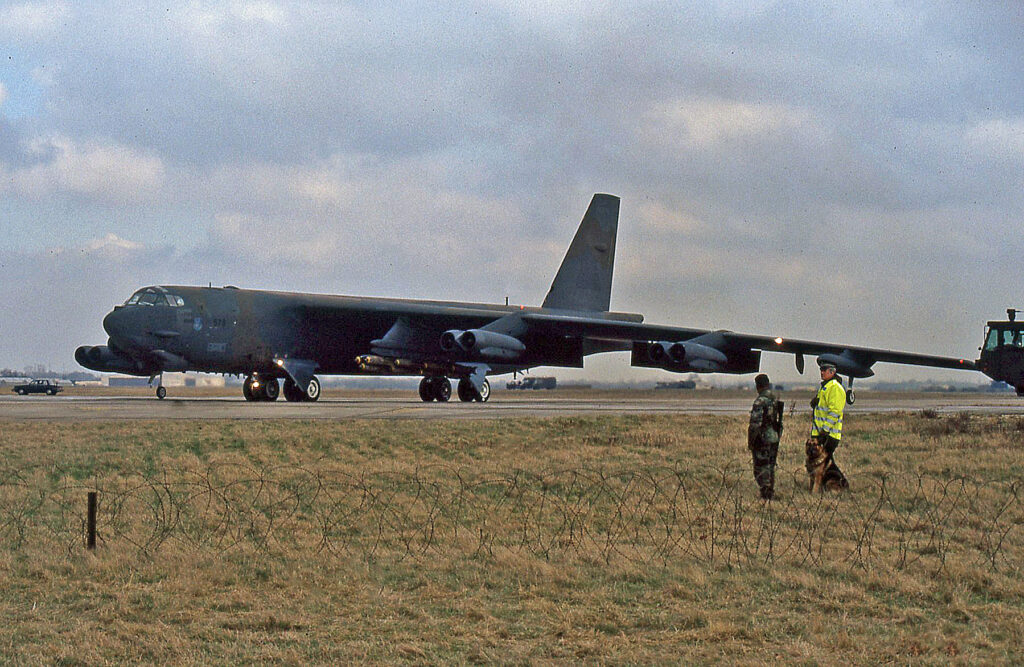
In 1991, with the build-up of tensions surrounding Iraq’s invasion of neighboring Kuwait, the Museum’s B-52 went into action again. Here, in the first Gulf War, the Stratofortress flew 14 combat missions over enemy territory, based out of both Moron, Spain and Fairford, England. One such mission which the Museum has records for occurred on February 6th, 1991, when the B-52 (along with five other examples) carried out a nighttime bombing run over Al-Iskandariyah, a major Iraqi Air Force base just south of Baghdad; the Stratofortresses, and their crews, spent more than 16 hours aloft on that mission.
Another Gulf War mission which the Tillamook Air Museum has documents for, shows that the B-52 performed a high altitude (38,000ft) bombing run over Northern Kuwait, targeting Iraqi minefields in preparation for the Allied ground invasion on February 23, 1991. On this particular mission, the airplane carried 52 Mk.82 bombs (each weighing 500lbs) to help blast a pathway through the enemy minefields. In total, the Museum’s B-52 flew 216.7 combat hours during the first Gulf War.
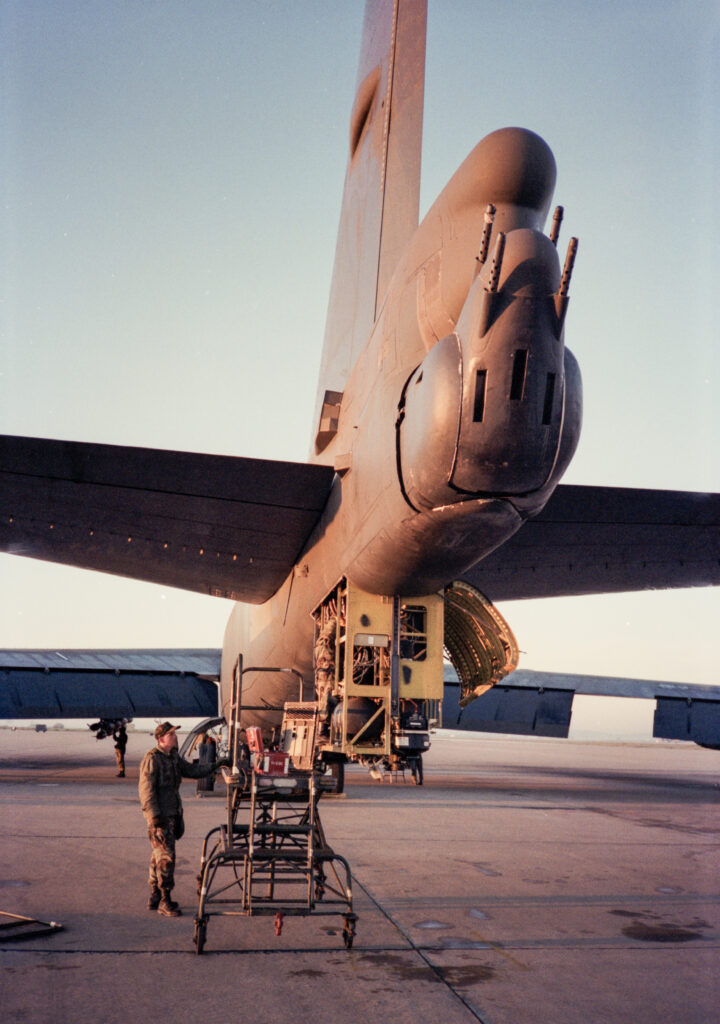
Shortly after the Gulf War, on November 12th, 1991, ‘579 retired to ‘The Boneyard’ at Davis-Monthan AFB in Tucson, Arizona. B-52G 52-2579 suffered the same fate as most other Stratofortresses in storage at the time, a wrecking crew cut the airframe into five pieces to satisfy the terms of disarmament treaties between the United States and the Soviet Union.
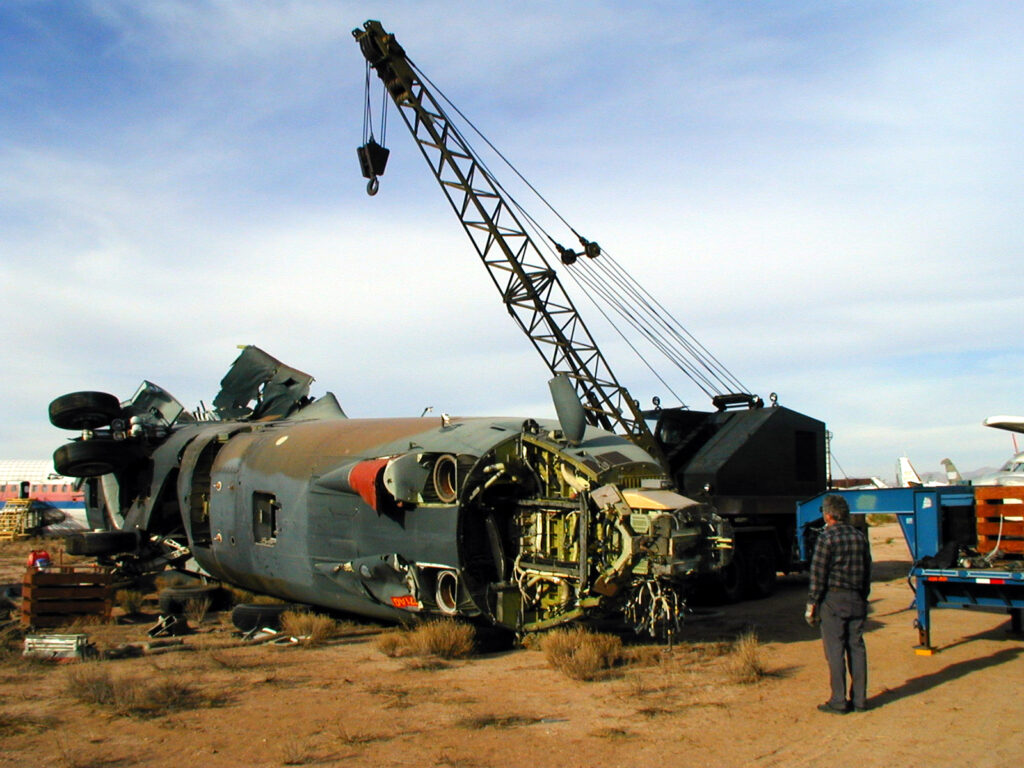
Thankfully the Southern Utah Aviation Museum saved the old bomber’s forward fuselage and began preparing it for display at their facility in St. George, Utah. When that museum closed, however, Doug Scroggins acquired the cockpit for his business, Scroggins Aviation Mockup & Effects, one of the leading suppliers of aviation props to Hollywood movies. Unfortunately, after Scroggins took possession, hooligans vandalized the cockpit with spray paint.
The subsequent power washing effort to remove the graffiti unfortunately also ruined the airplane’s then-current paintwork. Scroggins Aviation subsequently loaned the B-52 cockpit to the Tillamook Air Museum, where it arrived on September 8, 2021.
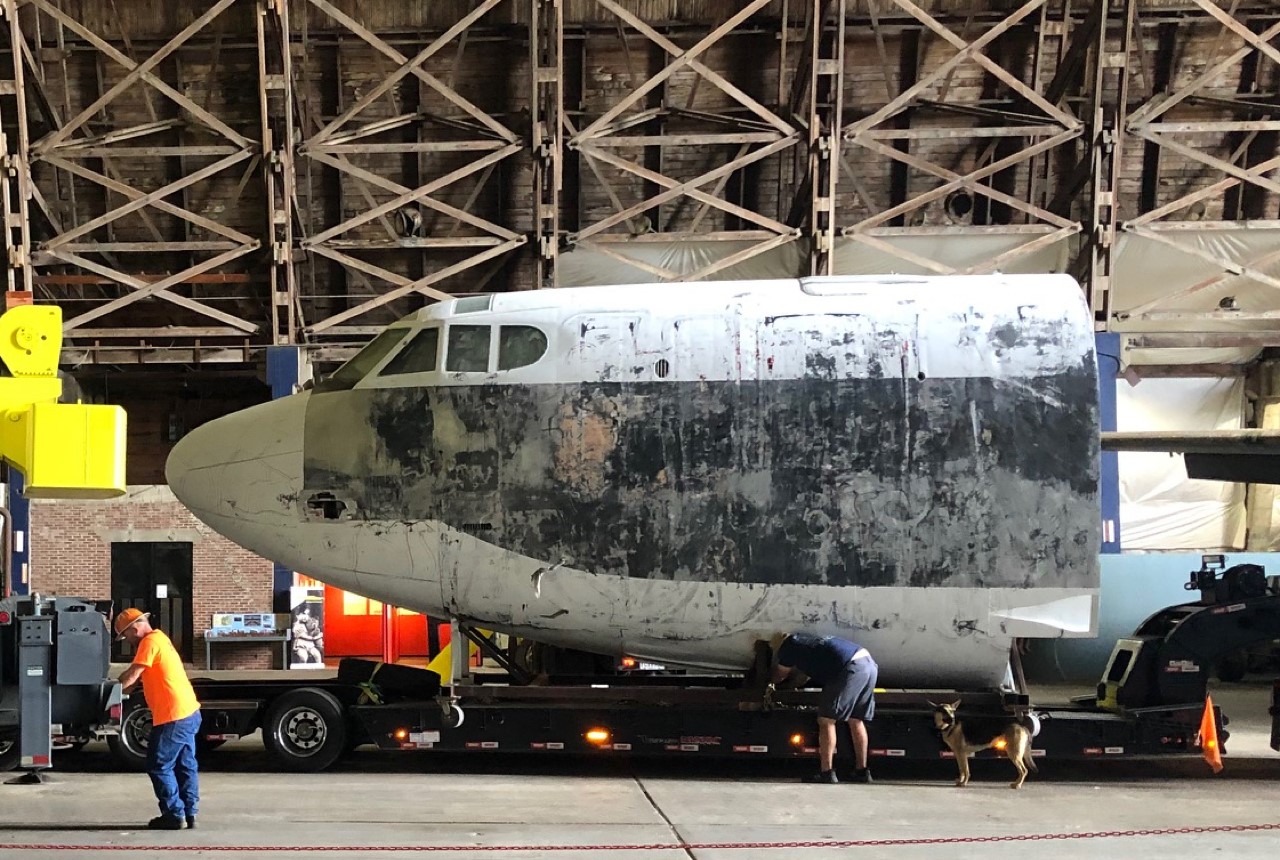
After its arrival in Tillammok, museum volunteers quickly got to work revitalizing the tired warrior, repainting the cockpit with the livery it wore during the Gulf War to celebrate and honor its service in that conflict. Other items they tackled included the interior lighting, external markings, audio-visual elements, cockpit details, and interpretive signage. Due to the lack of a dedicated restoration space at Tillamook, the rehabilitation effort took place on the museum’s floor. Curator Christian Gurling believes that this added an exciting bonus for visitors, who, as he stated, could “see first-hand the enormous amount of labor that goes into such a restoration project.” Complementing this, Gurling added: “Since the ship [was] already on display at the museum, we made the decision to ‘open’ the exhibit to our visitors, albeit as a work in progress.”
Gurling further noted: “The proper ‘Grand Opening’ and ribbon cutting of the B-52 cockpit will take place on Saturday, April first, 2023. In order to introduce that ‘wow factor’ into the opening, we have invited the woman who originally christened the bomber as the ‘City of Bangor’ in 1964, ‘Miss Bangor’ of that year, Sherylee Kay Jones, now Sherry Lowe, to attend the ceremony and ‘re-christen’ the airplane, the same aircraft that she Christened 59 years ago! This time it will be christened, ‘Osiris’, the name given to it during the Gulf War era.”
With respect to the grand opening, Gurling stated: “We are also inviting several other special guests to the B-52’s Grand Opening who had a direct connection to this specific airplane and its years of military service. I think by bringing this disparate, multi-generational group of people together during the B-52’s grand opening, will be a fun, exciting, but also moving way in which to celebrate the legacy of this historic aircraft.”
For those interested in more details, the B-52 has a dedicated Facebook page and museum personnel are keen to hear from anyone who has a connection with the aircraft and its long service, particularly for the unveiling and rechristening on April 1st.





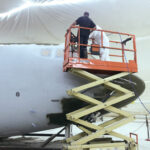
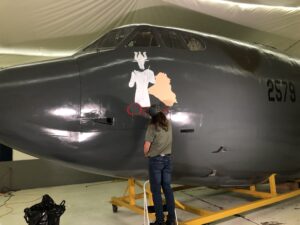
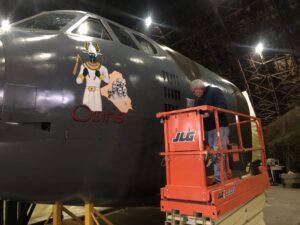
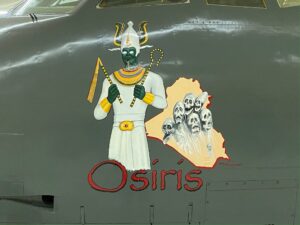
Be the first to comment
Graphic Design, Branding and Aviation Art